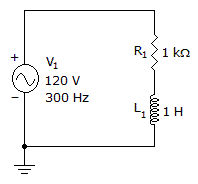Inductors problems
- 1. What term is used to describe the action of magnetic flux from one circuit that cuts across the conductors of another circuit?
Options- A. self-inductance
- B. rectification
- C. mutual inductance
- D. magnetism Discuss
Correct Answer: mutual inductance
- 2. Find VR and VL.

Options- A. VR = 41.6 V, VL = 78.4 V
- B. VR = 48 V, VL = 110 V
- C. VR = 56 V, VL = 106 V
- D. VR = 60 V, VL = 60 V Discuss
Correct Answer: VR = 56 V, VL = 106 V
- 3. Faraday's law states that the:
Options- A. direction of the induced voltage produces an opposition
- B. direction of an induced current produces an aiding effect
- C. emf depends on the rate of cutting flux
- D. emf is related to the direction of the current Discuss
Correct Answer: emf depends on the rate of cutting flux
- 4. A transformer is used:
Options- A. to couple electric energy from one dc circuit to another
- B. to couple electric energy from an ac circuit to a dc circuit
- C. to couple electric energy from a dc circuit to an ac circuit
- D. to couple electric energy from one ac circuit to another Discuss
Correct Answer: to couple electric energy from one ac circuit to another
- 5. The unit of flux density is:
Options- A. magnetomotive force
- B. a weber
- C. a maxwell
- D. a tesla Discuss
Correct Answer: a tesla
Explanation:
tesla or weber/m2 is the unit of flux density
- 6. The time difference, or lag, between flux density and magnetizing force is known as:
Options- A. eddy current
- B. magnetic saturation
- C. hysteresis
- D. coercivity Discuss
Correct Answer: hysteresis
- 7. The time required for one weber of flux to cut a conductor and produce one volt is:
Options- A. one revolution
- B. one second
- C. one millisecond
- D. four revolutions Discuss
Correct Answer: one second
- 8. If the primary of a 4:1 turns transformer dissipates 5 W, what is the secondary power?
Options- A. 5.0 W
- B. 1.25 pW
- C. 9.5 W
- D. 20.0 mW Discuss
Correct Answer: 5.0 W
- 9. A change of one ampere per second in an inductor that induces a voltage of one volt is considered as which unit value?
Options- A. a lenz
- B. an ohm
- C. a farad
- D. a henry Discuss
Correct Answer: a henry
- 10. What is electromagnetism?
Options- A. the magnetic field generated around a conductor when a current passes through it
- B. the magnetic field generated in a conductor by an external voltage
- C. the voltage caused by a magnetic field in a conductor
- D. the current generated by an external magnetic field Discuss
Correct Answer: the magnetic field generated around a conductor when a current passes through it
More in Electronics:
Programming
Copyright ©CuriousTab. All rights reserved.
